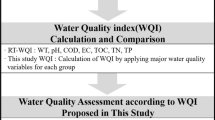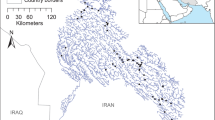Abstract
Composite Water Quality Identification Index (CWQII) and multivariate statistical techniques were used to investigate the temporal and spatial variations of water quality in Honghu Lake. The aims are to explore the characteristics of water quality trends in annual, monthly, and site spatial distribution and to identify the main pollution factors. The results showed that the values of CWQII increased from 2.0 to 4.0 from the years 2001 to 2005, then decreased from 2006 and kept a balance between 2.0 and 3.0 from 2006 to 2011, indicating that the water quality of Honghu Lake deteriorated from 2001 to 2005 and has gradually improved since 2006, which were likely achieved after water protection measurements taken since 2004. The monthly change rules of water quality were influenced by a superposition of natural processes and human activities. In samples numbered 1–9 from upstream to downstream, the maximum values of CWQII often occurred in sample site 9 while the minimum ones often occurred in sample site 2, indicating that the water quality near the upstream tributary was the poorest and that in the core zone was the best. Incoming water from the trunk canal of the Sihu area upstream was the largest pollution source. The sensitive pollution nutrients were mainly caused by the total nitrogen, followed by the total phosphorus.







Similar content being viewed by others
References
Association American Public Health. (1998). Standard methods for the examination of water and wastewater, 20th edition. Washington, DC: American Water Works Association and Water and Environmental Federation.
Chen, S. (2001). Environmental problems and ecological countermeasures for Hong Lake in Hubei Province. Journal of Central Chinese Normal University (Nature Science), 35(1), 107–110 (In Chinese).
Chen, H. Y., Teng, Y. G., & Wang, J. S. (2012). A framework of characteristics identification and source apportionment of water pollution in a river: a case study in the Jinjiang River, China. Water Sci Technol, 65, 2071–2078.
Cheng, X., & Li, S. (2006). Evolution and character of the representative lakes in the middle and lower reaches regions of Yangtze River. Chin Sci Bull, 51(7), 848–855 (In Chinese).
Cordoba, R., & Vargas, J. A. (1996). Temperature, salinity, oxygen, and nutrient profiles at a 200 m deep station in Golfo Dulce, Pacific coast of Costa Rica. Rev Biol Trop, 44, 233–236.
Frigge, M., Hoaglin, D. C., & Iglewicz, B. (1989). Some implementations of the boxplot. Am Stat, 43, 50–54.
Keith, B., & Jim, F. (2001). Equifinality, data assimilation, and uncertainty estimation in mechanistic modelling of complex environmental systems using the GLUE methodology. J Hydrol, 249(1–4), 11–29.
Kutser, T., Arst, H., Miller, T., et al. (1995). Telespectrometrical estimation of water transparency, chlorophyll-a and total phosphorus concentration of Lake Peipsi. Int J Remote Sens, 16, 3069–3085.
Li, F. F., Li, C., Xiao, B. L., et al. (2013). Mapping large-scale distribution and changes of aquatic vegetation in Honghu Lake, China, using multitemporal satellite imagery. J Appl Remote Sens, 7.
Liikanen, A., Murtoniemi, T., Tanskanen, H., et al. (2002). Effects of temperature and oxygen availability on greenhouse gas and nutrient dynamics in sediment of a eutrophic mid-boreal lake. Biogeochemistry, 59, 269–286.
Liu, S., Lou, S., Kuang, C., et al. (2011). Water quality assessment by pollution-index method in the coastal waters of Hebei Province in western Bohai Sea, China. Mar Pollut Bull, 62(10), 2220–2229.
Miao, Q., Gao, Y., Liu, Z. Q., et al. (2009). Application of comprehensive water quality identification index in water quality assessment of river intelligent systems. Intelligent Systems, 1, 333–337. GCIS '09. WRI Global Congress, Xiamen, China ,19-21 May 2009.
Mo, M., Wang, X., & Wu, H. (2009). Ecosystem health assessment of Honghu Lake wetland of China using artificial neural network approach. Chinese Geography Science, 19(4), 349–356.
Sedgwick, P. (2012). Pearson’s correlation coefficient. Br Med J, 344.
Semiz, G. D., & Aksit, C. (2013). Water quality, surface area, evaporation and precipitation of Lake Burdur. Journal of Food Agriculture ,& Environment, 11, 751–753.
SEPA. (2002). Environmental quality standard for surface water (EQSSW), GB 3838–2002.State Environment Protection Administration (SEPA), General Administration for Quality Supervision, Inspection and Quarantine of PR China, BeiJing. http://www.jstykj.com/en/Release/review.asp?id=66. Accessed 1 June 2002.
Sim, C. H., Gan, F. F., & Chang, T. C. (2005). Outlier labeling with boxplot procedures. J Am Stat Assoc, 100, 642–652.
Steinman, B. A., & Abbott, M. B. (2013). Isotopic and hydrologic responses of small, closed lakes to climate variability: hydroclimate reconstructions from lake sediment oxygen isotope records and mass balance models. Geochimica Et Cosmochimica Acta, 105, 342–359.
Wang, S., & Dou, H. (1998). China Lake. Beijing: Science (In Chinese).
Wang, H. J., Pong, J. H., & Liang, K. F. (2007). Application of comprehensive water quality identification index in water quality assessment of reservoir. Yangtze River, 38(1), 92–94 (In Chinese).
Xu, Z. X. (2005). Composite water quality identification index for environmental quality assessment of surface water. Journal of Tongji University (Natural Science), 4(33), 482–488.
Xu, Y. F., Ma, C. Z., Huo, S. L., et al. (2012). Performance assessment of water quality monitoring system and identification of pollution source using pattern recognition techniques: a case study of Chaohu Lake, China. Desalin Water Treat, 47, 182–197.
Xue, Q., & Liu, J. (2004). Methods and analyses of water pollution comprehensive index assessment. Environment Engineering, 22(1), 64–69 (In Chinese).
Yang, H., & Cai, S. (1995). The chemical structure of the ecological environment in Honghu Lake. Acta Ecol Sin, 15(4), 392–398 (In Chinese).
Yao, S. C., Xue, B., & Xia, W. L. (2006). Human impact recorded in the sediment of Honghu Lake, Hubei, China. Journal of Environmental Sciences-China, 18, 402–406.
Yilmaz, I. (2007). Fuzzy evaluation of water quality classification. Ecol Indic, 7(3), 710–718.
Zhang, L., Du, Y., Wu, S. J., et al. (2012). Characteristics of nutrients in natural wetland in winter: a case study. Environ Monit Assess, 184, 5487–5495.
Acknowledgments
The authors acknowledge the financial and technical support for this project provided by the CRSRI Open Research Program (Program SN.CKWV2012315/KY), National Key Basic Research and Development Program 973 plan (project no. 2012CB417001), and National Natural Science Foundation of China (project no. 51109195). The authors wish to thank the students and teachers who help to test the water samples in the Key Laboratory for Environment and Disaster Monitoring and Evaluation, Institute of Geodesy and Geophysics, Chinese Academy of Sciences.
Author information
Authors and Affiliations
Corresponding author
Rights and permissions
About this article
Cite this article
Ban, X., Wu, Q., Pan, B. et al. Application of Composite Water Quality Identification Index on the water quality evaluation in spatial and temporal variations: a case study in Honghu Lake, China. Environ Monit Assess 186, 4237–4247 (2014). https://doi.org/10.1007/s10661-014-3694-9
Received:
Accepted:
Published:
Issue Date:
DOI: https://doi.org/10.1007/s10661-014-3694-9




